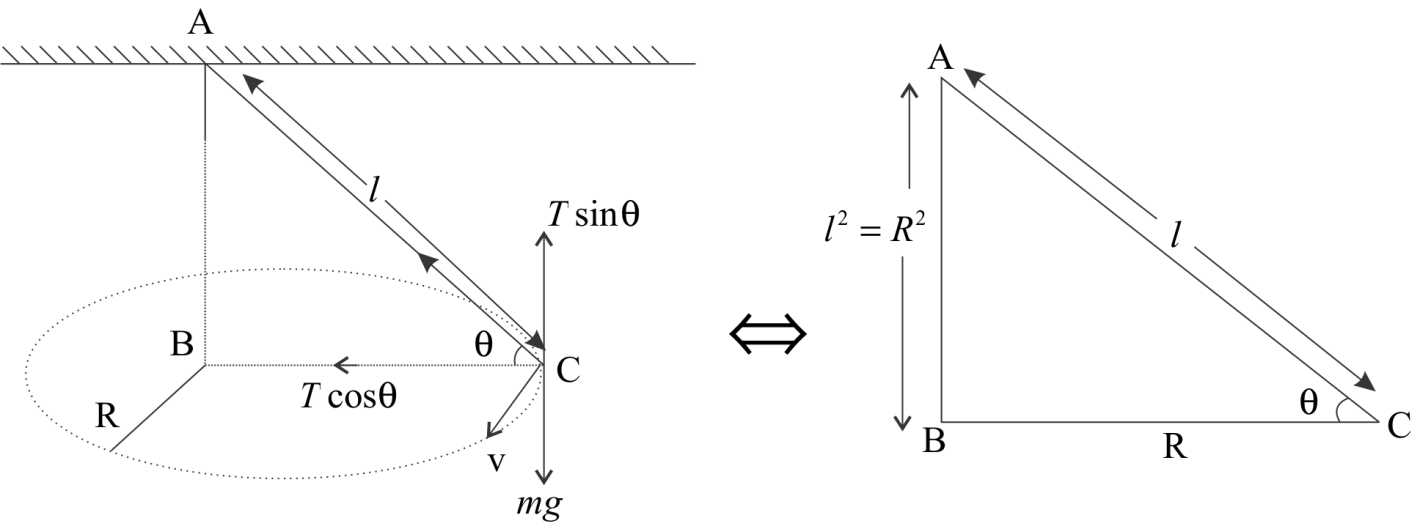
In a Conical pendulum, a string of length $120cm$ is fixed at rigid support and carries a mass $150g$at the end. If the mass is revolved in a horizontal circle of radius $0.2m$ around a vertical axis, Calculate the tension in the string. $(g = 9.8\dfrac{m}{{{s^2}}})$
Answer
222.9k+ views
Hint: In order to solve this equation, we first have to draw a free body diagram of the body. After that, we have to balance the Net force that is acting on the body. All the forces should be in accordance with Newton's third law. We can easily find the solution after balancing all the forces in all the given directions.
Formula Used:
$Centripetal Force$ = $\dfrac{{m{V^2}}}{r}$
$m$ is the mass of body
$V$ is the velocity of body
$r$ is the radius of circle & Secondly, Net force on a body is equal to $0$ i. e. ${F_{net}} = 0$
Complete step by step answer:
Here, a conical pendulum, a string of length $120cm$ & mass of $150g$ & given we have to calculate the Tension $T$ in the String.
In order to understand the Question, Let’s draw a free body diagram of a pendulum.
Free Body Diagram:

Here the mass $m$ is moving in a circular motion of radius $0.2m$ with velocity $V.$ The Force acting on a mass $m$ will be
${F_{net}} = \dfrac{{m{V^2}}}{r}$
Here, the Tension $T$ will be resolved into two components $T\sin \theta $ (in vertical direction) and $ \uparrow \cos \theta $ (in horizontal direction). Now balancing all forces we get
In Vertical Direction:
$T\sin \theta = mg - (i)$
Now,
In Horizontal plane,
$T\cos \theta = $ Horizontal force on a mass $m$ (i.e. Centripetal force)
So,
$T\cos \theta = \dfrac{{m{V^2}}}{r} - (ii)$
So, from eq. we get
$T = \dfrac{{mg}}{{\sin \theta }}$
Now, In $\Delta ABC$, we get $\sin \theta = \dfrac{P}{H}$
So, $\sin \theta = \dfrac{{\sqrt {{l^2} - {R^2}} }}{l}$
Putting the value of $\sin \theta $in eq. $(1)$ we get
$T = \dfrac{{mgl}}{{\sqrt {{l^2} - {R^2}} }}$
Further,
$T = \left( {\dfrac{{150}}{{1000}}} \right)\dfrac{{(9.8) \times 120}}{{\sqrt {{{(120)}^2} - {{(20)}^2}} }}$ $[1kg = 1000g,1m = 100cm]$
$T = 1.52$ Newton.
Hence, the tension on the string will be $1.52$N.
Note: While solving this question, we have to be very careful with directions. Only forces acting in the same direction will balance each other. Also according to Newton's third law, action and reaction occur on different bodies. So we have to be careful while applying it to anybody. the units for every force should be the same.
Formula Used:
$Centripetal Force$ = $\dfrac{{m{V^2}}}{r}$
$m$ is the mass of body
$V$ is the velocity of body
$r$ is the radius of circle & Secondly, Net force on a body is equal to $0$ i. e. ${F_{net}} = 0$
Complete step by step answer:
Here, a conical pendulum, a string of length $120cm$ & mass of $150g$ & given we have to calculate the Tension $T$ in the String.
In order to understand the Question, Let’s draw a free body diagram of a pendulum.
Free Body Diagram:

Here the mass $m$ is moving in a circular motion of radius $0.2m$ with velocity $V.$ The Force acting on a mass $m$ will be
${F_{net}} = \dfrac{{m{V^2}}}{r}$
Here, the Tension $T$ will be resolved into two components $T\sin \theta $ (in vertical direction) and $ \uparrow \cos \theta $ (in horizontal direction). Now balancing all forces we get
In Vertical Direction:
$T\sin \theta = mg - (i)$
Now,
In Horizontal plane,
$T\cos \theta = $ Horizontal force on a mass $m$ (i.e. Centripetal force)
So,
$T\cos \theta = \dfrac{{m{V^2}}}{r} - (ii)$
So, from eq. we get
$T = \dfrac{{mg}}{{\sin \theta }}$
Now, In $\Delta ABC$, we get $\sin \theta = \dfrac{P}{H}$
So, $\sin \theta = \dfrac{{\sqrt {{l^2} - {R^2}} }}{l}$
Putting the value of $\sin \theta $in eq. $(1)$ we get
$T = \dfrac{{mgl}}{{\sqrt {{l^2} - {R^2}} }}$
Further,
$T = \left( {\dfrac{{150}}{{1000}}} \right)\dfrac{{(9.8) \times 120}}{{\sqrt {{{(120)}^2} - {{(20)}^2}} }}$ $[1kg = 1000g,1m = 100cm]$
$T = 1.52$ Newton.
Hence, the tension on the string will be $1.52$N.
Note: While solving this question, we have to be very careful with directions. Only forces acting in the same direction will balance each other. Also according to Newton's third law, action and reaction occur on different bodies. So we have to be careful while applying it to anybody. the units for every force should be the same.
Recently Updated Pages
JEE General Topics in Chemistry Important Concepts and Tips

JEE Extractive Metallurgy Important Concepts and Tips for Exam Preparation

JEE Atomic Structure and Chemical Bonding important Concepts and Tips

JEE Amino Acids and Peptides Important Concepts and Tips for Exam Preparation

Electricity and Magnetism Explained: Key Concepts & Applications

JEE Energetics Important Concepts and Tips for Exam Preparation

Trending doubts
JEE Main 2026: Application Form Open, Exam Dates, Syllabus, Eligibility & Question Papers

Derivation of Equation of Trajectory Explained for Students

Hybridisation in Chemistry – Concept, Types & Applications

Understanding the Angle of Deviation in a Prism

How to Convert a Galvanometer into an Ammeter or Voltmeter

Degree of Dissociation: Meaning, Formula, Calculation & Uses

Other Pages
JEE Advanced Marks vs Ranks 2025: Understanding Category-wise Qualifying Marks and Previous Year Cut-offs

Thermodynamics Class 11 Physics Chapter 11 CBSE Notes - 2025-26

Units And Measurements Class 11 Physics Chapter 1 CBSE Notes - 2025-26

NCERT Solutions For Class 11 Physics Chapter 8 Mechanical Properties Of Solids

Motion in a Straight Line Class 11 Physics Chapter 2 CBSE Notes - 2025-26

Laws of Motion Class 11 Physics Chapter 4 CBSE Notes - 2025-26




